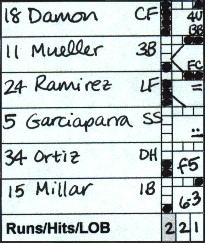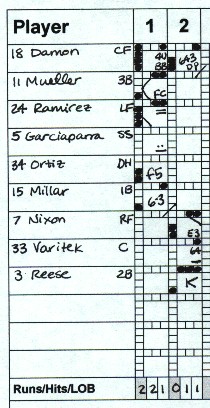|
How to Score a Game
Any person claiming to be a baseball fan who does not also claim to have invented the quickest, simplest and complete method of keeping score is probably a fraud.
– Thomas Boswell
Before the game, record the lineups in the "Player" column, noting uniform numbers and position.
When scoring, use the numbers 1-9 to represent the different fielding positions as follows:
| 1 | Pitcher |
|---|
| 2 | Catcher |
|---|
| 3 | First Base |
|---|
| 4 | Second Base |
|---|
| 5 | Third Base |
|---|
| 6 | Shortstop |
|---|
| 7 | Left Field |
|---|
| 8 | Center Field |
|---|
| 9 |
Right Field |
|---|
|
As each player bats, record the outcome in his row under the appropriate inning. Mark balls and strikes by coloring the small boxes around the outside of the box. Use the boxes on the side for balls and the ones across the top for strikes. Thus

represents a 3-1 count.
Outs are recorded by noting the position number of the fielder who made the putout (and assist, if any). For example, a fly out to center would simply be 8, while a groundout to the shortstop would be 6-3 (shortstop to first base). If you like, you may further designate balls hit in the air by using F9 for a fly to right, L5 for a liner to third, or (lowercase) f 7 for a foul ball caught by the left fielder. You may also use U for ground outs which a player makes unassisted. Thus a popup to first base could be F3 or just 3, while a grounder handled by the first baseman alone would be 3U. Strikeouts are recorded with a K if the batter strikes out swinging, and a  if he strikes out looking. if he strikes out looking.
More Scoring Symbols
| K | Strikeout (swinging) |
|---|
 | Strikeout (looking) | | BB | Walk |
|---|
| IBB | Intentional walk |
|---|
| FC | Fielder's choice |
|---|
| HBP | Hit by pitch |
|---|
| SB | Stolen base |
|---|
| CS | Caught stealing |
|---|
| SF |
Sacrifice fly |
|---|
| SH |
Sacrifice hit |
|---|
BK | Balk | WP | Wild pitch | PB | Passed ball | E | Error | | HR | Home run |
|---|
F | Fly out | L | Line out | f | Foul out | | U | Unassisted |
|---|
|
|---|
Hits are recorded as follows: A single horizontal line – represents a single, two lines = represent a double, and three lines = represent a triple. Home runs are designated by HR. RBI can be designated by placing the appropriate number of dots next to the symbols for single, double, etc. Thus =: would show a two-run double. To record a player's movement around the bases, think of the square as the basepaths, with the lower left-hand corner as home plate, the lower right-hand corner as first base, and so on. Use these symbols and those in the box to the left to chart the player's movement around the bases. For example, a player singles to center. Mark a single line – in the lower right-hand corner. He then steals second. Put SB in the upper right-hand corner to show how he got to second. He then moves to third when the next batter singles. Put a diagonal line / in the upper left-hand corner to show that he advanced to
third. If he later scores, put a \ in the bottom left-hand corner to show that he came home.
At the end of each inning, total the team's Runs, Hits, and Left on Base. When a new pitcher enters the game, record the previous pitcher's Innings Pitched, Runs, Earned Runs, Hits, Walks, and Strikeouts in the columns provided. At the end of the game, complete the box score by writing each player's total At-Bats, Runs, Hits, RBI, and Walks in the shaded boxes. These columns may also be used for extra innings if the game goes beyond the tenth.
Use the blank area at the bottom to note the umpires, the weather, the attendance, or anything else.
The most important thing to remember when scoring is that you can make up your own system, too. You may want to record what part of the field a base hit went to, player ejections, etc. (See the additional suggestions below for ideas on how to handle these situations.) Follow these general rules and use your imagination, and you'll have everything you need to keep a complete record of the game.
A Scoring Example
 Damon walks on a 3-1 count. Write BB in the bottom right corner to show how he got on first.
Damon walks on a 3-1 count. Write BB in the bottom right corner to show how he got on first.
On a 1-2 count, Mueller grounds to second. Damon is retired by the second baseman, and Mueller is safe at first on a fielder's choice. 4U is written in the top right of Damon's box to record the unassisted out at second. Mueller gets FC in the lower right.
With the count full, Ramirez hits a double (two lines in the top right). Mueller advances to third, indicated by a slash in the top left of his box.
Garciaparra swings at the first pitch and hits a single, scoring both runners. He gets one line for the single, and two dots for the 2 RBI. Mueller and Ramirez get slashes in the bottom left to show that they scored.
On a 2-0 count, Ortiz hits a popup which the third baseman catches in foul territory. It's an f 5.
With a 1-1 count, Millar grounds to the shortstop, who fires to first for the out. The play is 6 (shortstop) to 3 (first base).
At the end of the inning, there are two runs, two hits, and one left on base.

| Another Scoring Example
A small diagonal line at the end of Millar's box indicates the end of the inning, and reminds you to start the next inning in column 2. To start the second, Nixon leads off, and reaches on an error by the first baseman (E3).
Varitek hits a single on an 0-1 pitch. Nixon moves to second, as shown by the diagonal line in the top right corner of his box.
Reese follows with a strikeout (swinging) after a 1-2 count.
Damon (still in the second inning column) hits a grounder to short. The shortstop throws to second to retire Varitek (thus the 6-4 in the top right of his box), and then on to first to retire Damon on the 6-4-3 double play.
At the end of the inning, there are no runs, one hit, and one man left on base (Nixon).
|
Additional Suggestions
You may want to make scoring more detailed. If you want to record what part of the field a base hit was hit to, you could mark the position number after the hit symbol. For example, –7 for a single to left, or .=8 for an RBI double to center.
When the opposing pitcher is taken out of the game, darken the bottom line of the box of the last batter he faced. That way it will be easy to tell when he left. Likewise, when a position player leaves the game, darken the side of his box in the last inning that he played. I also like to put a T or B in the box by a substitute's name to indicate whether he entered in the top or bottom of the inning. If more than nine players come to bat in an inning, continue the tenth batter in the next inning's column, then renumber the column headings.
You can make up your own symbols and record whatever else you want, like RD for rain delay, BCB for bench-clearing brawl, EJ for ejection, etc. You can use an asterisk * or exclamation point ! to indicate a spectacular defensive play. You could even use \ for a called strike, / for a swinging strike, and • for a foul in the ball and strike boxes rather than coloring them in, if you wanted to further differentiate each pitch.
On the other hand, you can skip the balls and strikes altogether and just record a player's hits and outs. Scoring can be as simple or as complex as you want it to be, but either way you'll have a complete yet concise record of the game when you're done!
|

